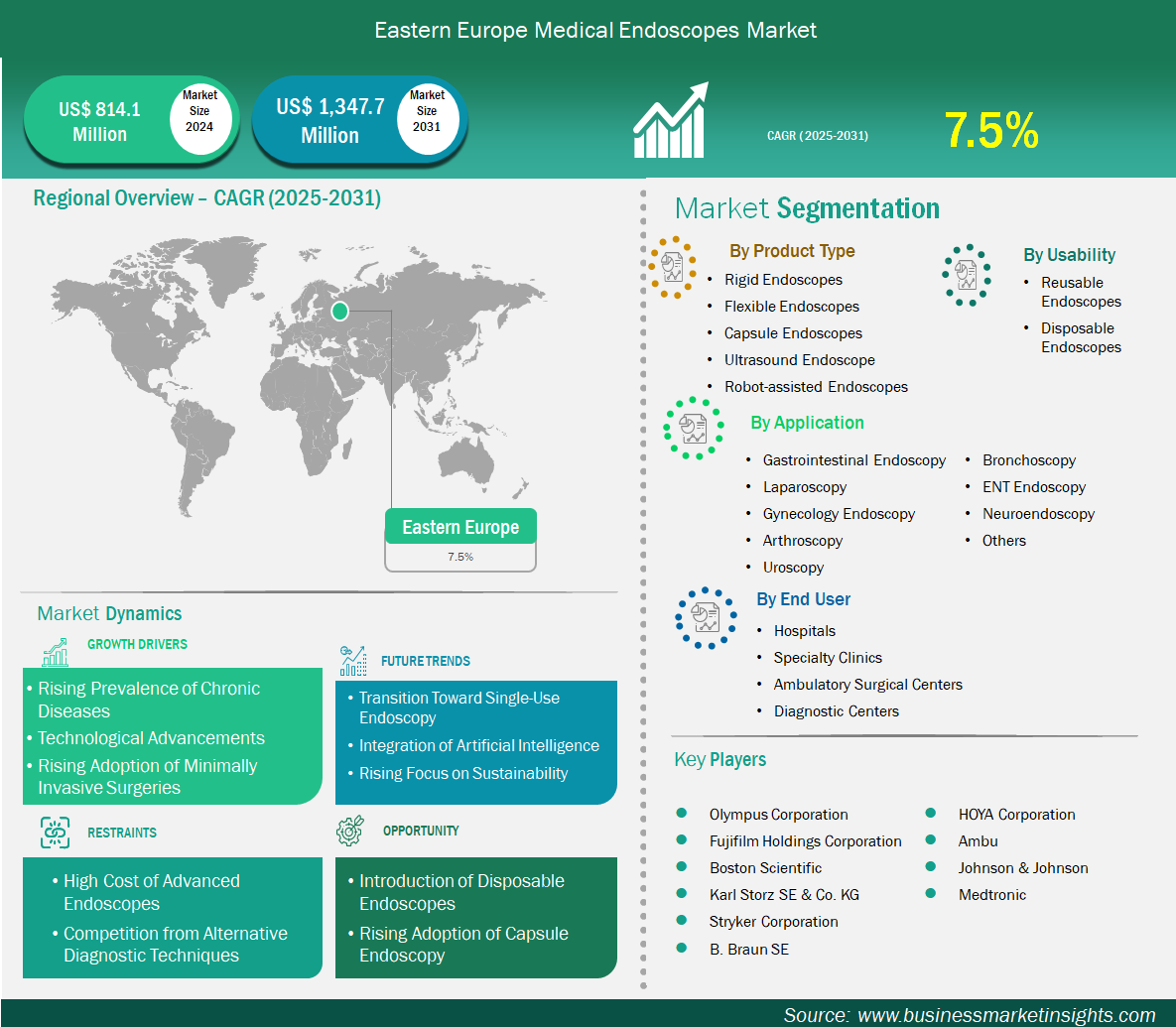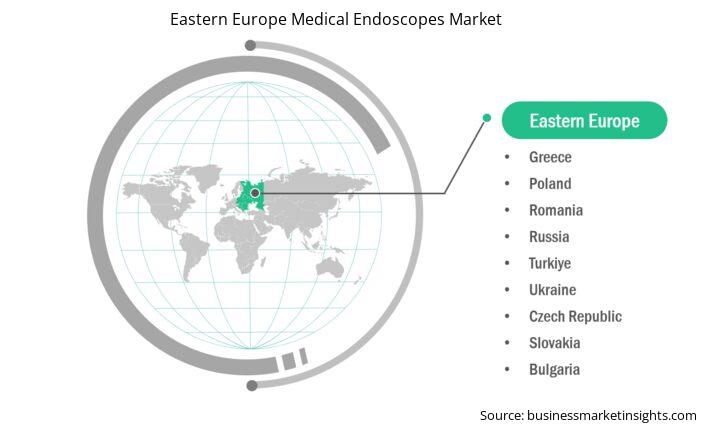Eastern Europe Medical Endoscopes Market Outlook (2021-2031)
No. of Pages: 150 | Report Code: BMIPUB00031749 | Category: Life Sciences
No. of Pages: 150 | Report Code: BMIPUB00031749 | Category: Life Sciences
Eastern Europe medical endoscopes market size is expected to reach US$ 1,347.7 million by 2031 from US$ 814.1 million in 2024. The market is estimated to record a CAGR of 7.5% from 2025 to 2031.
Eastern Europe is one of the emerging markets, with increasing demand for advanced diagnostic equipment and minimally invasive treatments. Poland, Czech Republic, Hungary, Romania, Bulgaria, and Slovakia are all making incremental improvements to their healthcare infrastructure through both state investment and European Union capital.

Key segments that contributed to the derivation of the medical endoscopes market analysis are product type, application, and end user.
Eastern Europe is an emerging region of the market with increasing interest in advanced diagnostic equipment and minimally invasive procedures. Poland, the Czech Republic, Hungary, Romania, Bulgaria, and Slovakia are
increasing steadily in their upgrading of healthcare systems, helped both by government programmes and by funding from the European Union.
Public hospitals throughout the region are increasingly introducing advanced endoscopic equipment, mostly for gastrointestinal and gynecological procedures. Although large cities have flexible and rigid endoscopes, small towns and rural areas, on the other hand, tend to experience issues of inappropriate equipment, budget constraints, and staff shortages.
Private health care is growing in most countries of Eastern Europe, providing more quality services and investing in newer tools such as HD and Al-assisted endoscopes. Systems of reimbursement, however, are quite diverse and can influence the rate of adoption.
As healthcare reforms persist and training schemes strengthen, Eastern Europe will witness moderate but consistent growth in endoscope utilization, particularly within secondary and tertiary care institutions.
Based on country, the Eastern Europe medical endoscopes market is further segmented into the Russia, Turkiye, Poland, Ukraine, Romania and Greece. The Russia held the largest share in 2024.
The medical endoscope market in Russia has a lot of potential, thanks to a big population and a push to improve healthcare facilities. The government is working on programs to boost diagnostic tools in local hospitals, which is leading to more use of endoscopy tech. There’s an increasing number of stomach issues, cancers, and breathing problems, particularly in older people and those living in cities, which is raising the need for endoscopic tests and treatments.
While most endoscope use happens in public hospitals, private healthcare is growing quickly in major cities and is starting to use newer technologies like 4K imaging and single-use endoscopes. Still, the market has some challenges, such as reliance on imports, complicated regulations, currency fluctuations, and geopolitical issues that might disrupt the supply of medical equipment. Despite these challenges, Russia is still seen as a key market for long-term growth, especially for companies that can handle its complex buying processes and build local partnerships and services.
| Report Attribute | Details |
|---|---|
| Market size in 2024 | US$ 814.1 Million |
| Market Size by 2031 | US$ 1,347.7 Million |
| CAGR (2025 - 2031) | 7.5% |
| Historical Data | 2021-2023 |
| Forecast period | 2025-2031 |
| Segments Covered |
By Product Type
|
| Regions and Countries Covered | Eastern Europe
|
| Market leaders and key company profiles |
|
Olympus Corporation, Johnson & Johnson, Karl Storz SE & Co. KG, Smith+Nephew, Medtronic, Boston Scientific, B. Braun SE, Stryker Corporation, Fujifilm Holdings Corporation, HOYA Corporation, Ambu A/S are among the key players operating in the market. These players adopt strategies such as expansion, product innovation, and mergers and acquisitions to stay competitive in the market and offer innovative products to their consumers.
The following methodology has been followed for the collection and analysis of data presented in this report:
The research process begins with comprehensive secondary research, utilizing both internal and external sources to gather qualitative and quantitative data for each market. Commonly referenced secondary research sources include, but are not limited to:
Note: All financial data included in the Company Profiles section has been standardized to US$. For companies reporting in other currencies, figures have been converted to US$ using the relevant exchange rates for the corresponding year.
Business Market Insights conducts a significant number of primary interviews each year with industry stakeholders and experts to validate and analyze the data and gain valuable insights. These research interviews are designed to:
Primary research is conducted via email interactions and telephone interviews with industry experts across various markets, categories, segments, and sub-segments in different regions. Participants typically include:

The Eastern Europe Medical Endoscopes Market is valued at US$ 814.1 Million in 2024, it is projected to reach US$ 1,347.7 Million by 2031.
As per our report Eastern Europe Medical Endoscopes Market, the market size is valued at US$ 814.1 Million in 2024, projecting it to reach US$ 1,347.7 Million by 2031. This translates to a CAGR of approximately 7.5% during the forecast period.
The Eastern Europe Medical Endoscopes Market report typically cover these key segments-
The historic period, base year, and forecast period can vary slightly depending on the specific market research report. However, for the Eastern Europe Medical Endoscopes Market report:
The Eastern Europe Medical Endoscopes Market is populated by several key players, each contributing to its growth and innovation. Some of the major players include:
The Eastern Europe Medical Endoscopes Market report is valuable for diverse stakeholders, including:
Essentially, anyone involved in or considering involvement in the Eastern Europe Medical Endoscopes Market value chain can benefit from the information contained in a comprehensive market report.